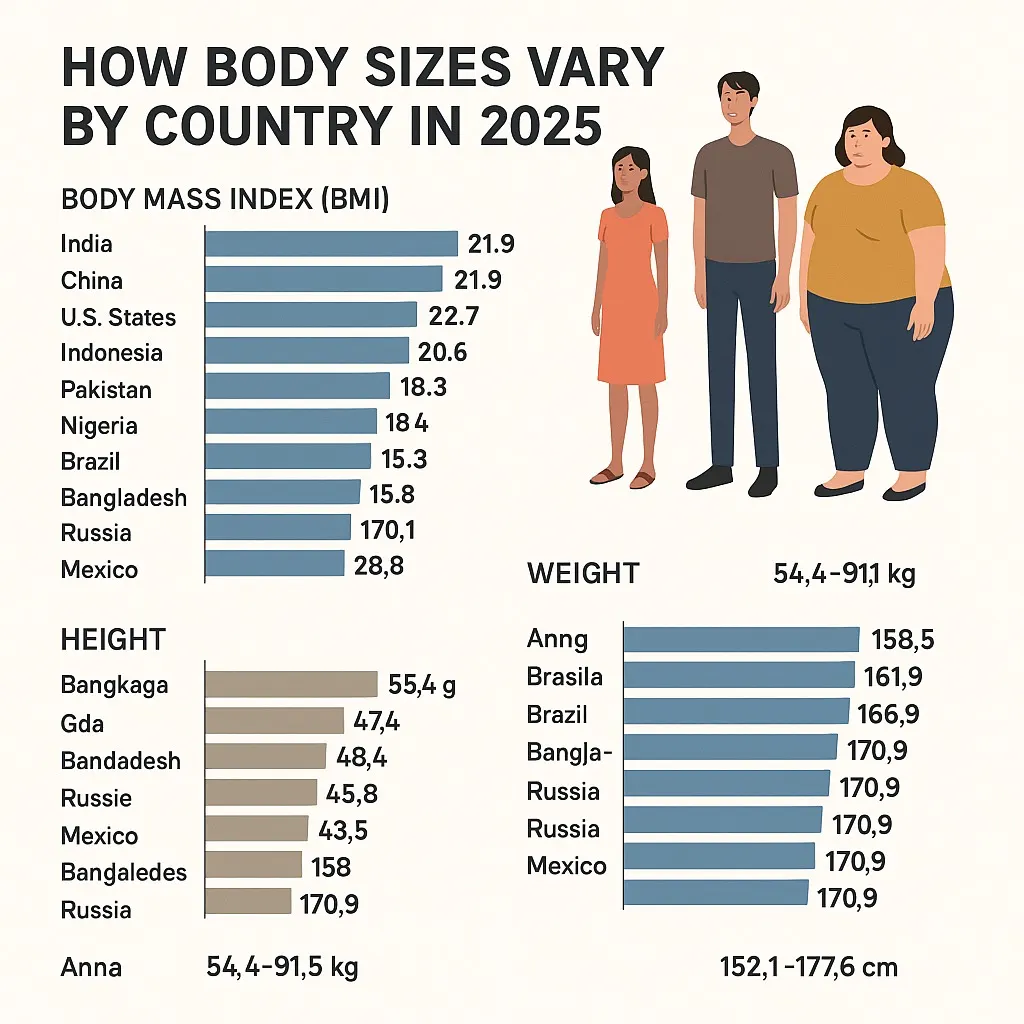
In 2025, the assortment of human body sizes across the globe reflects the connection of genetics, nutrition, lifestyle, and socio-economic development. From tall Russians to petite Bangladeshis, the average adult’s height, weight, and Body Mass Index (BMI) vary significantly from one nation to another. Exploring the top 10 most populous countries provides us stark evidence. The countries we studied were China, India, the United States, Indonesia, Pakistan, Nigeria, Brazil, Bangladesh, Russia, and Mexico.
Of these, the United States remains the global leader in average body mass, with adult men averaging 201.7 pounds and women 173.9 pounds, giving rise to BMIs of 29.3 and 29.7 respectively—figures just shy of the medical obesity threshold (BMI ≥ 30) (NCD Risk Factor Collaboration, 2025). In sharp contrast, adults in Bangladesh are among the world’s leanest: men average 133.2 pounds, women 119.9 pounds, with BMIs of 22.3 and 23.5 respectively.
Variations in height can serve as indicators of economic and health disparities. Americans and Russians are among the tallest, with men averaging 69.7 inches (5’9.7″) and women 64.2 to 64.6 inches (5’4.2″–5’4.6″). Meanwhile, South Asian nations like Bangladesh and India have average male heights of just 65.0 to 65.4 inches (5’5″–5’5.4″), with women often below 61 inches (5’1″)—a reflection of long-standing childhood malnutrition.

Body Mass Index (BMI), which balances height and weight, provides a more general indicator of body composition. Nations like the U.S., Mexico, Brazil, and Russia have average adult BMIs between 26 and 29, placing the majority of adults in the overweight range. Mexico’s women average a BMI of 29.2, one of the highest in the world. In comparison, countries such as India and Bangladesh have rates around 22 to 23, with a notable portion of their population still underweight.
These variations point out the “double burden” of malnutrition—a term used by global health experts to describe the simultaneous prevalence of undernutrition and obesity. In Nigeria, for example, some rural populations suffer stunting and low BMI, while urban areas report increasing overweight and obesity rates. Similarly, in India, more than 20% of women are underweight in rural areas, while obesity in cities like Delhi is climbing rapidly (WHO, 2025).
Socioeconomic status significantly forecasts height. In countries with good healthcare, education, and stable food supplies, a taller population manifests itself. In contrast, lower-income countries face food insecurity, resulting in shorter average height and weight. In places where urbanization and Western diets have become prevalent we see an increase obesity rates, regardless of starting heights.
In summary, 2025 highlights a changing global landscape. Countries face unique challenges with obesity and undernutrition, requiring diverse solutions shaped by their histories and lifestyles.
Sources: NCD Risk Factor Collaboration, World Health Organization, Global Nutrition Report, World Obesity Atlas (2025).
